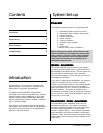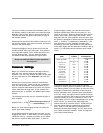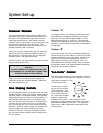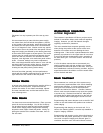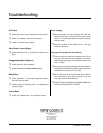
Page 5
STATEMENT Set-up Manual
PlacementPlacement
PlacementPlacement
Placement
Placement is a very important part of the set up proce-
dure.
We recommend that you start with the system roughly
two meters from the wall behind the speakers, woofers
on the outside of the stat panels, woofer fronts flush with
and beside the stat panel frame fronts. Recommended
toe-in is 10 degrees or less. Narrow rooms may require
the woofers to be on the inside of the stat panels. Sound-
stage and imaging are affected by the relative placement
of the woofers with respect to the stat panels. The woofer
columns may be moved back half way between the stat
panels and the wall, however, this will affect the bass
response, time alignment, and woofer/stat panel relative
levels. Crossover settings may need re-adjustment.
Also, even though the best results seem to occur with the
stat panel cable connector polarity dots up, time align-
ment variations may warrant experimentation with
inverting the stat panel polarity (red dot down).
We have found that, generally, the best performance
results with the woofers positioned close to the left and
right walls and to the outside of the stat panels.
Narrow RoomsNarrow Rooms
Narrow RoomsNarrow Rooms
Narrow Rooms
A narrow room almost dictates that the woofers will be to
the inside of the stat panels. Experiment with the
position that results in the widest soundstage, tightest
and most extended bass, and the best balance at the
lower midrange area.
Wide RoomsWide Rooms
Wide RoomsWide Rooms
Wide Rooms
You have more room to experiment here. Place your stat
panels for the best soundstage. You will find that they
can be placed quite far apart and still provide excellent
middle center staging with the stage width extending
beyond the outer edges of both stat panels. Initially, try
placing the woofers to the outside of the stats, close to
the side walls.
WW
WW
W
oofer/Roofer/R
oofer/Roofer/R
oofer/R
oom Interactionoom Interaction
oom Interactionoom Interaction
oom Interaction
vs.Time Alignment
vs.Time Alignment
The crossover is provided at 125 Hz so you have some
latitude for movement without much trade-off regarding
imaging. However, you will find dramatic changes
regarding woofer/room placement.
The most extended bass response generally occurs
when placing the woofers at the corners of the room,
however a horn effect can occur affecting the lower
midrange area. If the woofer is placed between the stats,
generally a prominence in the upper bass will occur due
to rear wall reflection enhancement, with a recession in
the lower bass (your “Fun Factor Control” will solve this
problem).
It is for the above reasons that we recommend your
starting position begin with the woofers to the outside
and parallel with the frontal plane of the stats. Once you
have established a reference listening condition, begin to
experiment and don’t be afraid to move the woofer tower
all over the back wall area.
RR
RR
R
oom Toom T
oom Toom T
oom T
reatmentreatment
reatmentreatment
reatment
Room treatment is a crucial part of the system set up.
We recommend experimentation with sound absorbing
panels and/or diffusers. It is most important to avoid
sonic glare from reflections off the wall behind the
speakers and behind the listener. Consider, however,
that too much acoustic treatment may cause the system
to sound too dry. We have found that a 2' wide panel 6'
tall placed directly behind the stat panel on the wall can
be very effective without damping the sound too much.
Experimenting with center dampers such as the ASC half
rounds on the wall between the speakers can enhance
center staging.
Experimenting with damping on the back wall, if it is
close to the listening position, can also help establish a
superior imaging condition.
Experimenting with damping on the side walls directly to
the side of the stat panels, particularly in narrow rooms,
can result in superior imaging and reduced “glare” in
conditions where the room and wall surfaces are hard.




